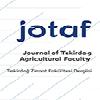Türkiye'de İncir Üretiminin Geleceği
Future of Fig Production in Turkey
___
- Abdullah, L. 2012. ARIMA model for gold bullion coin selling prices forecasting. IJAAS 1(4):153-158.
- Anonymous. 2017a. The ARIMA Models. Retrieved in November, 29, 2015 from http://people.duke.edu/~rnau/411arim.htm.
- Anonymous. 2017b. Dry Fig Annual Report, 2013. Customs and Trade Ministry. General Directorate of Cooperatives in February, 2014.
- Anonymous. 2017c. Aegean Dried Fruits and Products Exporters' Union. Retrieved in November, 29, 2017 from http://www.egeliihracatcilar.com/StandartRaporlar/KuruMeyve2011.2012.htm.
- Bal, E. 2012. Effect of postharvest UV-C treatments on quality attributes of fresh fig. Bulgarian J. Agric. Sci. 18(2):191-196.
- Box, G. E. P. and G. M., Jenkins, 1970. Statistical Models for Forecasting and Control. Holden Day, San Francisco.
- Bulbul, S., H. Atil and S Hepaksoy, 1997. A general study of commercial dried fig production in the Big Meander Valley of Turkey. In I International Symposium on Fig. 480:317-320.
- Cobanoglu, F., H. Kocatas, M. Ozen, E. Tutmus and R. Konak 2007. An evaluation of approach in determination of climate factors impact on dried fig exportation in Turkey J. Fac. Agric. OMU, 22(1):11-19.
- Eriten, A. 2005. Estimates of demand relationships for figs and figs products in Turkey. Middle East Technical University, Graduate School of Social Sciences, Master Thesis, Ankara.
- DFAR. 2017. Dry Fig Annual Report (DFAR), 2015. Customs and Trade Ministry. General Directorate of Cooperatives in February, 2016. Retrieved in December 23, 2017, from http://koop.gtb.gov.tr/data/56e959311a79f5b210d9176d/2015%20Kuru%20%C4%B0ncir%20Raporu.pdf.
- FAOSTAT. 2017. Classifications and standarts. Retrieved in November, 29, 2017 from http://faostat.fao.org/site/535/DesktopDefault.aspx?PageID=535#ancor
- Finley, J. W. 2005. Proposed criteria for assessing the efficacy of cancer reduction by plant foods enriched in carotenoids, glucosinolates, polyphenols and seleno compounds. Annals of Botany. 95(7):1075-1096.
- Flaishman, M. A., V. Rover and E. Stover, 2008. The fig: botany, horticulture and breeding. Hort. Rev. 34:113-197.
- Hiwale, S. 2015. Fig (Ficus carica). In Sustainable Horticulture in Semiarid Dry Lands. Springer India p 159-175.
- Isin, F., T. Cukur and G. Armagan, 2007. Factors affecting the adoption of the organic dried fig agriculture system in Turkey. J. Appl. Sci. 7(5):748-54.
- ITC. 2017. Trade of fig. Retrieved in December, 05, 2017 from http://www.trademap.org/Bilateral_10D_TS.aspx.
- Joseph, B. and S. J. Raj, 2011. Pharmacognostic and phytochemical properties of Ficus carica Linn–An overview. Int. J. Pharm.Tech. Res. 3(1):8-12.
- Kocatas, H. 2014. Determination of the effects of chilling periods of some fig cultivars and hydrogen cyanamide (H2CN2). treatment on earliness. Adnan Menderes University Graduate School of Natural and Applied Sciences, Master Thesis, Aydin, Turkey.
- Moharrampour, M, S. Sohrabi and J. Vakili, 2013. Comparison of Support Vector Machines (SVM). and Autoregressive integrated moving average (ARIMA). in daily flow forecasting. SCIJOUR 1(1):1-10.
- Mombeini, H. and A. Yazdani-Chamzini, 2014. Developing a new approach for forecasting the trends of oil price. BMR 4(3):120-132.
- Patil Vikas, V., S. C. Bhangale and V. R. Patil, 2010. Evaluation of anti-pyretic potential of ficus carica leaves. IJPSR 2(2):48-50.
- Ramesh, D., B. Bhattacharyya and R. Biswas, 2014. Forecasting of maize production in Andhra Pradesh by ARIMA modeling. Environ. Ecol. 32 (4B):1709-1713.
- Sezen, I., S. Ercisli and S. Gozlekci, 2014. Biodiversity of figs (Ficus carica l.). in Coruh valley of Turkey. ErwerbsObstbau. 56(4):139-146.
- Silva, L. C., M. N. Harder, P. B. Arthur, R. B. Lima, D. M. Modlo and V. Arthur, 2009. Physical-chemical characteristics of figs (Ficus carica). preready to submitted to ionizing radiation. International Nuclear Atlantic Conference, ISBN: 978-85-99141-03-8.
- Stover, E., M. Aradhya, L. Ferguson and C. H. Crisosto, 2007. The fig: overview of an ancient fruit. HortSci. 42(5):1083-1087.
- Teoh, T. T., S. Cho Yand, Y. Y. Nguwi, 2012. Emotional prediction using time series multiple-regression genetic algorithm for autistic syndrome disorder. In Computer ICCSE, 2012 7th International Conference on p. 9-12.
- Turhan, S., M. Nargelecekenler, and B. Cetin, 2013. A hedonic analysis of Bursa's Black Fig bid prices and product quality characteristics in Turkey. JFAE 11(1):264-267.
- Turk, R. 1988. Effects of harvest time and precooling on fruit quality and cold storage of figs. In International Symposium on Postharvest Handling of Fruit and Vegetables. 258:279-286.
- TURKSTAT. 2017. Turkish Statistical Institute. Retrieved in November, 29, 2017 from http://www.turkstat.gov.tr/UstMenu.do?metod=kategorist.
- Vinson, J. A. 1999. The functional food properties of figs. Cereal Food World. 4:82-87.
- Vinson, J. A., L. Zubik, P. Bose, N. Samman, and J. Proch, 2005. Dried fruits: excellent in vitro and in vivo antioxidants. JACN 4:44-50.
- Wang, W. C., K. W. Chau, D. M. Xu and X. Y. Chen, 2015. Improving forecasting accuracy of annual runoff time series using ARIMA based on EEMD decomposition. Water Res. Manage. 1-21. DOI 10.1007/s11269-015-0962-6.
- Wasseja, M.M. and S. N. Mwenda, 2015. Analysis of the volatility of the electricity price in Kenya using autoregressive integrated moving average model. SJAMS, 3(2):47-57.
- Yavuz, F., A. Bilgic, M. Terin and I. O. Guler, 2013. Policy implications of trends in Turkey's meat sector with respect to 2023 vision. Meat Science 95(4):798-804
- ISSN: 1302-7050
- Yayın Aralığı: 3
- Başlangıç: 2004
- Yayıncı: Namık Kemal Üniv. Tekirdağ Ziraat Fak.
Buğdayda Fusarium culmorum’a Ruhsatlı Olmayan Fungisitlerin Patojen Üzerine Etkisi
Nagehan Desen KÖYCÜ, Füsun SUKUT
Yaygın Yonca Çeşitlerinin Bazı Besin Maddesi İçeriklerinin Belirlenmesi
Food Safety Perceptions of Fresh Fruits and Vegetables Consumers
Özge Can NİYAZ, Nevin DEMİRBAŞ
İrfan ÖZTÜRK, Kayıhan Z. Korkut
Buğdayda Fusarium culmorum’a Ruhsatlı Olmayan Fungisitlerin Etkisi
Nagehan Desen KÖYCÜ, Füsun SUKUT
The Effect of Different Vermicompost Doses on Wheat (Triticum vulgaris L.) Nutrition
Neriman Tuba BARLAS, Borahan CÖNKEROĞLU, Gonca UNAL, Korkmaz BELLİTÜRK
Türkiye'de İncir Üretiminin Geleceği
Ahmet Semih UZUNDUMLU, Muhammet Emre ÖKSÜZ, Seval KURTOĞLU
Hatay İlinde Pamuk Üretiminin Fonksiyonel Analizi
Arif SEMERCİ, Ahmet Duran ÇELİK
Bazı Böcek Türlerinin Yemlerde Kullanım Olanakları
Kübra Melis SABUNCUOĞLU, Firdevs KORKMAZ TURGUD, Hasan Ersin ŞAMLI
